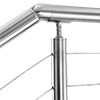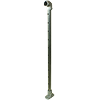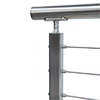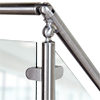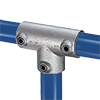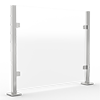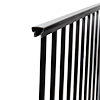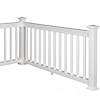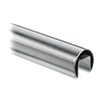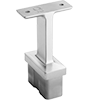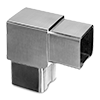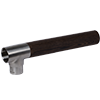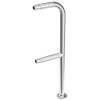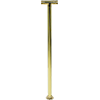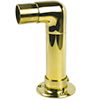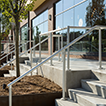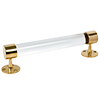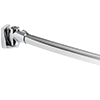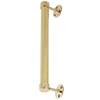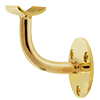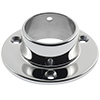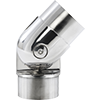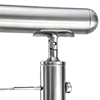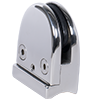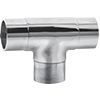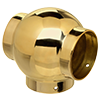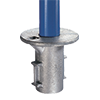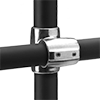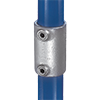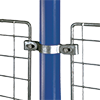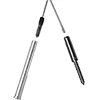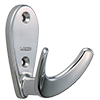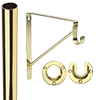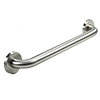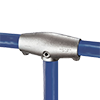Placement of Grab Bars Around Toilet
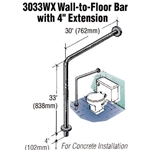 Installing a grab bar in your accessible bathroom is a critical upgrade that can offer a big improvement in safety for elderly and disabled guests.
Installing a grab bar in your accessible bathroom is a critical upgrade that can offer a big improvement in safety for elderly and disabled guests.
Once you have decided to install a safety bar, you may have the same question as most people: where should toilet grab bars be placed?
Luckily, the ADA toilet grab bar requirements are relatively easy to understand and follow.
The Americans with Disabilities Act of 1990 (ADA) is a civil rights law that prohibits discrimination based on disability. It is important to follow the guidelines set forth by the ADA so that the Grab Bar is accessible to all people.
Even if your toilet grab bar installation will be in a residence, the ADA rules help ensure that your grab bar will be safe and supportive.
Safety grab bars for toilets are an indispensable safety feature in bathrooms. The CDC tells us that 81% of injuries in bathrooms are caused by falls.
Many of these incidents could be avoided with a proper grab bar installation.
Please keep reading for the ADA toilet grab bar dimensions, location, and height requirements.
Where Should Bathroom Grab Bars Be Placed?
ADA toilet grab bar locations are outlined in ADA Standards 604.5 and 604.8.1.5. The standard recommends the use of a side wall grab bar located on the wall that is closest to the toilet.
In addition, they recommend that over the toilet grab bars be used as well.
Toilet grab bar placement is an important consideration and is usually the first step when installing grab bars. Take the time to review the ADA Standards to ensure that your grab bars are properly placed.
Some exceptions do apply to the standards mentioned. If the bathroom is only accessible through a private office and is not for public use, then grab bars are not required to be installed.
Additionally, residential units and detention facilities are not required to have grab bars installed.
Why Are Grab Bars Placed Behind A Toilet?
The placement of grab bars around toilet areas allows wheelchair-bound and elderly people to sit down with ease.
Without it, they may be unable to operate the toilet controls or sit and stand properly.
ADA Requirements for Bathroom Grab Bars
The ADA Standards provide straightforward guidelines for handicapped toilet grab bar height, size, and other factors. The walls and surfaces near a grab bar must be smooth and the edges must be rounded.
The grab bar cannot rotate within its fittings. In other words, it must be sturdy and tight.
The grab bar, mounting devices, fasteners, and supporting structures must be able to withstand forces of up to 250 pounds.
ADA Compliant Bathroom Grab Bar Height
The ADA toilet grab bar height is defined in Standard 609.4. The grab bar must be installed in a horizontal position. It must be between 33 and 36 inches (840-915 mm) in height above the floor when measured to the top of the grab bar’s surface.
If the bathroom is for children’s use (as defined in ADA Standard 604.9), then the grab bars must be between 18 and 27 inches (455-685 mm) in height above the floor when measured to the top of the grab bar’s surface.
According to ADA Standard 604.7, if the sidewall grab bar is located beneath a toilet paper dispenser, then the toilet paper dispenser must be a maximum of 48 inches (1220 mm) in height from the floor.
ADA Compliant Bathroom Grab Bar Dimensions
According to ADA Standards section 609, the diameter of a grab bar must be between 1.25 and 2 inches (or 32-51 mm).
If the grab bar is not circular, it must not have a cross-section measurement of over 2 inches.
In addition, the perimeter must be between 4 and 4.8 inches (100-120 mm).
The grab bar on the rear wall behind the toilet must be at least 36 inches (915 mm) long.
In addition, the rear wall grab bar must extend at least 12 inches (305 mm) from the center of the toilet to one side, while also extending at least 24 inches (610 mm) to the opposite side.
If other fixtures do not allow for 36 inches of length, then the rear grab bar is allowed to be a minimum of 24 inches (610mm) long.
Similarly, if the flush controls do not allow for the rear grab bar to be properly placed, the bar can be split or shifted to an open side of the toilet.
The grab bar on the sidewall must be at least 42 inches (1065 mm) long and must be located a maximum of 12 inches (305 mm) away from the rear wall. In addition, it must extend at least 54 inches (1370 mm) from the rear wall.
Toilet Grab Bar Locations
ADA Standard 609.3 outlines the spacing between the wall and the grab bar. The space between the two must be 1.5 inches (38 mm).
The space between the grab bar and the object below must be a minimum of 1.5 inches.
Any protruding fixtures above the grab bar must be at least 12 inches (305 mm) away.
Conclusion
Installing a grab bar near bathroom areas is an important safety feature in both commercial and residential bathrooms.
The grab bars allow for disabled and elderly people to use the restroom with the least amount of trouble. When commercial establishments install ADA compliant grab bars, they can benefit from happier, safer customers.
And if you are installing the grab bars at home, you will surely enjoy a safer bathroom experience for you and your family.
If you are looking for high-quality ADA compliant toilet grab bars, BuyRailings.com has you covered.
The stainless steel grab bars come in 24”, 36”, and 42” lengths, and installation is quick and easy.
The maximum load weight is 300 lbs., which is higher than the ADA requirements.
We provide a wide variety of rods and railings, including toilet ADA grab bars, shower grab bars, and many other high-quality railing products.











